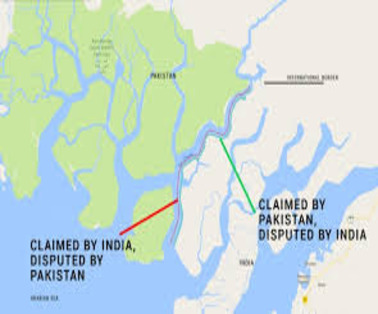Pakistan has objected to India’s construction of Border Outposts (BOP) at Sir Creek in Gujarat, a site where the boundary line is disputed by both the sides. India has insisted that the construction is well within its territory.
What is Sir Creek? The India-Pakistan Border Dispute Explained
- Sir Creek is a 96-km strip of water located in the Rann of Kutch marshlands, a disputed area between India’s Gujarat state and Sindh Province in Pakistan.
- The creek has been at the heart of a territorial dispute between the two nations for decades, primarily over the interpretation of maritime boundaries.
- Understanding the historical context, strategic importance, and ongoing border issues is crucial to grasp the complexities of this dispute.
Historical Background Of The Sir Creek Boundary Conflict
- The Sir Creek dispute dates back to the British colonial period, when the area was part of the Bombay Presidency in British India.
- Following India’s independence in 1947, Sindh became part of Pakistan, and Kutch remained within India’s borders.
- The conflict primarily stems from different interpretations of boundary lines established under the Bombay Government Resolution of 1914, which Pakistan claims as evidence that the entire creek belongs to Sindh.
- India, however, asserts that the boundary lies mid-channel, as depicted in maps from 1925 and confirmed by the installation of mid-channel pillars in 1924.
- This disagreement over the boundary line, coupled with differing interpretations of the Thalweg Doctrine in international maritime law, has kept the issue unresolved.
What’s The Importance Of Sir Creek?
- Apart from strategic location,Sir Creek’s core importance is fishing resources.
- Sir Creek is considered to be among the largest fishing grounds in Asia.
- Another vital reason is the possible presence of great oil and gas concentration under the sea,which are currently unexploited thanks to the impending deadlock on the issue.
- Sir Creek is a strategically important region and Indian and Pakistani troops had clashed in the Rann of Kutch in the 1965 war.
- The area is also of great ecological importance with it being home to flamingoes and other species of migratory birds in the winters.
The Sir Creek Dispute: India’s and Pakistan’s Claims
-
Pakistan’s Position on Sir Creek:
Pakistan claims the entire creek as part of its territory, referencing Paragraphs 9 and 10 of the Bombay Government Resolution of 1914. This resolution, it argues, demarcates the boundary line along the eastern flank of the creek, known as the Green Line. -
India’s Position on Sir Creek:
India asserts that the boundary lies along the mid-channel of the creek, as outlined in a 1925 map. India’s argument is backed by the Thalweg Doctrine, which suggests that navigable water bodies, like Sir Creek, should be divided along their mid-channel. India maintains that the installation of mid-channel pillars in 1924 supports its claim.
Why the Sir Creek Dispute Matters?
-
Fishing Resources:
Sir Creek is one of the largest fishing grounds in Asia. Both India and Pakistan rely heavily on the fishing industry in the region. Disputes over maritime boundaries have led to issues of illegal fishing and clashes between local fishermen and border security forces. -
Oil and Gas Reserves:
Unresolved maritime boundaries prevent both countries from exploring and exploiting offshore oil and gas reserves in the area, a key economic opportunity for both nations. -
Strategic Location:
The creek’s location gives both nations access to important sea routes, making it critical for national security and maritime defense. The 1965 India-Pakistan war saw limited clashes in the Rann of Kutch, underlining the significance of this region.
Attempts at Resolving the Sir Creek Dispute

To Download Monthly Current Affairs PDF Click here
Get Inspiration from CLAT 2025 Topper
Click here to get a free demo
Everything About CLAT 2025
Sir Creek Dispute Frequently Asked Questions
What is the Sir Creek dispute between India and Pakistan?
The Sir Creek dispute is a territorial conflict between India and Pakistan over a 96-km stretch of water in the Rann of Kutch, with both countries claiming the boundary at different points
Why is Sir Creek important for India and Pakistan?
Sir Creek is crucial for its fishing resources, potential oil and gas reserves, and strategic location for maritime security.
What are the claims of India and Pakistan regarding Sir Creek?
Pakistan claims the creek belongs to Sindh based on a 1914 agreement, while India claims the boundary lies along the creek’s mid-channel.
What is the Thalweg Doctrine, and how does it relate to Sir Creek?
The Thalweg Doctrine states that river boundaries should follow the mid-channel, which India cites in its claim over Sir Creek.
What is the environmental significance of Sir Creek?
Sir Creek is an ecologically sensitive area, home to migratory birds like flamingos and important wetlands in the Rann of Kutch.



